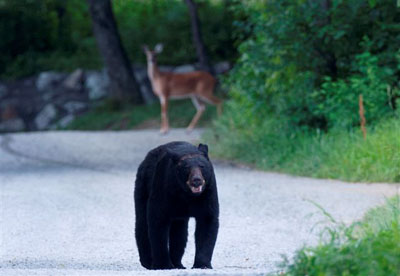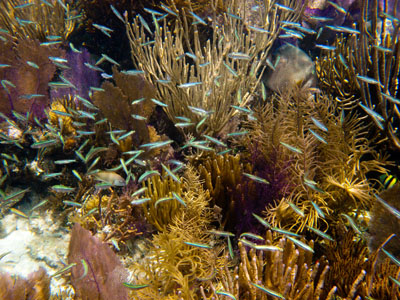
Parks seek balance of preservation, use
At a time when many in our country and around the world are worried about endangered species, both animal and vegetable, world warming and climate change, it is important to stop and think about the reasons for the existence of our National Parks.
What is the impact of tourism and development on these specially designated spaces of our country?
According to the U.S. Travel Association, in 2010 alone more than 70 international tour operators promoted our national parks for their largest market strategy, their Pow Wow, and this was an added promotion to President Obama’s support of the Great Outdoors and National Export Initiative.
We understand the premise that parks, natural or man-made, are destined for our enjoyment and the park administrators must find a balance between the benefits and the drawbacks of the people who visit the parks.
| Click on the video at the right to view an audio slide show about the impact of tourism on national parks narrated and prepared by writer Mari Centeno-Ayala. Photos courtest of the National Park Service. |
The ideal morning for any camp-lover visiting Great Smoky Mountains National Park begins early in the day; it’s the best time to explore the park and maybe find a hidden natural treasure. The picture perfect scene is interrupted by the sudden, choppy sound of a helicopter above carrying the other type of a park tourist.
Noise pollution is just one of the disadvantages The Great Smoky Mountains National Park faces while tourists visit the park. Imagine taking a hike and not being able to enjoy the sound of running water from the river or the birds chirping in the trees. Instead, one is met by noise pollution.
However, according the Park’s Managing Assistant Bob Miller, things have improved and under Tennessee State Law companies now offering helicopter tours must be nine miles from park boundaries.
This alone has greatly improved the area inside the park and has made tourist visits more enjoyable. The park is visited by more than 9.5 million tourists a year. During the slower season (September-October) the park is more focused on special events and improving things around the park and during the high season (July-August.) this is hard to accomplish.
The park is highly visited during spring break and summer months and these high seasons have a big impact on the park. Many of the tourists visiting the park are un-experienced and few take the time to look over park regulations.
| A bear roams through Cade’s Cove in Great Smoky Mountain National Park in Tennessee (Photo by Susie Neel, courtesy of the National Park Service). |  |
Some of the more popular park activities that tourist enjoy are bicycling, horse back riding, picnicking, visiting historic buildings, camping and fishing.
According to Miller, one of the most popular tourist activities is driving through the park and about four million cars pass through the park; the impact caused by this level of traffic not only on the air, but also on the vegetation and fauna of the park is noticeable.
Most visitors are the commuter type, that is they are only visiting the park for a day; they are not camping inside the park. During the high season, this type of tourist creates huge wear and tear on the road and air and garbage pollution in the park.
However, Miller concedes that this high impact of tourist is not always negative. The Great Smoky Mountains National Park receives a lot political support and is highly recognized by the community and in 2010 was ranked the most visited park in the country.
According to Miller, in the last 10 to 15 years, operating costs have increased but considering the high volume of visits in the area and around the park and every one competing for federal funding, budgeting has also been easier. Tourists spend an average of $800 million dollars a year in the park and surrounding areas and this helps the local economy particularly restaurants and hotels.
Miller pointed out that something that is impacting the park is the housing development being built in its vicinity. Basically it’s affecting the animal population and specifically it affects the bear population because they tend to roam towards the homes and eat the garbage from these houses.
 |
Snorkeling around coral reef nurseries is a popular activity for visitors to Biscayne National Park in Florida (Photo courtesy of the National Park Service). |
One way they are dealing with this is a law in Tennessee that punishes intentional bear feeding outside the Park: people have to be in control of their garbage. The city of Gatlinburg has an ordinance that requires homeowners to have bear-proof trash containers and they are not allowed to leave the trash out.
As an added note, Miller mentioned the fact that the Great Smoky Mountains National Park is home to the Cherokee Indians; they receive the benefits of the tourist that visit the park, but they also receive the negative impact that comes with them.
Great Smoky Mountains National Park attracts the rugged tourist, the hiker and the mountain climber. For the tourist that wants more of an aquatic park with underwater exploration of historic treasures, innumerable types of birds and marine creatures, Florida has the perfect choice.
The Biscayne National Park represents a totally different type of natural experience. We go from a series of mountain ridges in Smoky National Park, to a mostly underwater world.
This National Park was almost lost to eager developers who back in the 1950’s saw the economic potential of using most of the area to create a fantastic city, which they called “City of Islandia.”
| Traffic in and around Great Smoky Mountains National Park has had a significant impact on the park and surrounding areas (Photo courtesy of the National Park Service). |
Luckly, the idea of ecology importance and environmental preservation were already growing strong around the country and the project was stopped. In 1968, President Lyndon B. Johnson signed the law that Congress had passed declaring Biscayne a National Park.
Biscayne National Park covers almost 178.000 acres and only five percent is above water. This means that most of the tourists visiting this park do it by traveling in boats of many types.
Matt Johnson, Supervisory Park Ranger/Interpreter, described the Park visitors as people mostly interested in water sightseeing and they have good steady flow of visitors all year. For the year 2010 it is estimated that around 915 thousand persons visited this park; according to the National Park Service Public Use Statistics Office (NPS-Stats); during that same year, the months that saw most tourist were January through March, with a combined total of 445 thousand visitors.
One major difference between visitors to this park and those that go to other national parks is the mode of transportation in and around the park. Walking and boating are the favorite ways for getting around and cars can only go so far, because the swampy terrain is preserved for the conservation of the natural life of the park inhabitants.
The favorite activities are snorkeling in the reefs and trying to find treasures in the sunken ships. They also go for fishing, kayaking and sailing. One of the characteristics of this park is that visitors come from all over the world and most of them are very concerned with environmental preservation.
| The Great Smoky Mountains National Park is the most-visited park in the national system (Photo courtesy of the National Park Service). |
Biscayne National Park also has a museum that offers audiovisual information about the park and everything it has to offer.
Johnson stated that one of the biggest concerns for the park administration is promoting education about the importance of taking care of all the park, this includes the coral reef, the fish and other fauna present in the park and the unique vegetation.
He mentioned noise produced by the motors on the boats as one of the biggest problems because it bothers the fauna. Trash left behind by visitors is another big problem.
Both Rob Miller and Matt Johnson reassured us that even though the tourism impact on our national parks is noticeable, it is not being ignored; both also emphasized the importance of education.

Comments are Closed